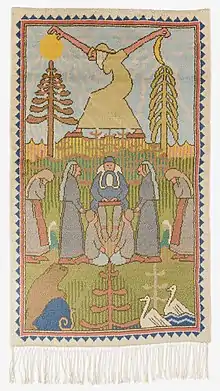
Louhi (Finnish pronunciation: [ˈlou̯hi]) is a wicked queen of the land known as Pohjola in Finnish mythology and a villain of the Kalevala. As many mythological creatures and objects are easily conflated and separated in Finnish mythology, Louhi is probably an alter-ego of the goddess Loviatar.
In mythology
Louhi is described as a powerful and evil witch queen ruling over the northern realm of Pohjola, with the ability to change shape and weave mighty enchantments. She is also the main opponent of Väinämöinen and his group in the battle for the magical artifact Sampo in the Kalevala.[1] She has a number of beautiful daughters, whom Ilmarinen, Lemminkäinen and other heroes attempt to win in various legends. In true fairy tale form, Louhi sets them difficult-to-impossible tasks to perform in order to claim such a prize, which leads to the forging of the Sampo.[2]
In popular culture
- Louhi was the main antagonist in the Finnish-Soviet film Sampo, played by Anna Orochko.[3]
- There is an orchestral work Louhi by the Finnish composer Kalevi Aho, and the wind orchestral work Louhi's Spells / Louhen loitsut by Finnish composer Tomi Räisänen.[4][5]
- Louhi is track 5 on Kesto, recorded by Pan Sonic.[6]
- Louhi was an inspiration for a foe of Conan the Barbarian's in the Marvel comics version of the character (no such foe ever appears in Howard's stories)[7]
- Final Fantasy: The 4 Heroes of Light features Louhi the Witch of the North as a boss, Final Fantasy XI features the item Louhi's Mask,[8] and Final Fantasy XIV features Louhi as a powerful ice enemy.
- Louhi is the main antagonist of Michael Scott Rohan's fantasy trilogy The Winter of the World.[9]
- Louhi is also one of the names of the witch Iggwilv in the Dungeons & Dragons game's Greyhawk campaign by Gary Gygax. In his book Sea of Death, Iggwilv is mentioned as being called Louhi on an alternate Earth.[10] Louhi is also mentioned in the supplement Deities & Demigods for the first edition of Advanced Dungeons & Dragons, as character part of the Finnish mythos. [11]
- Louhikäärme – Louhi's snake – is an archaic form of lohikäärme meaning "dragon" in Finnish.
Gallery
![Actress Mimmi Lähteenoja [fi] as Louhi in the National Theatre play Pohjolan häät (The Wedding at Pohjola) on the day the theatre opened, April 9 1902](../I/Mimmi_L%C3%A4hteenoja_Louhen_roolissa_Kansallisteatterin_Pohjolan_h%C3%A4%C3%A4t_vihki%C3%A4isn%C3%A4yt%C3%B6ksess%C3%A4_9.4.1901.jpg.webp) Actress Mimmi Lähteenoja as Louhi in the National Theatre play Pohjolan häät (The Wedding at Pohjola) on the day the theatre opened, April 9 1902
Actress Mimmi Lähteenoja as Louhi in the National Theatre play Pohjolan häät (The Wedding at Pohjola) on the day the theatre opened, April 9 1902 Louhi saves Väinämöinen, Robert Wilhelm Ekman, 1859–1860
Louhi saves Väinämöinen, Robert Wilhelm Ekman, 1859–1860![Ilmarinen Arrives as the Groom at Pohjola, charcoal work by Johan Kortman [fi], 1893](../I/Johan_Kortman_-_Ilmarinen_Arrives_as_the_Groom_at_Pohjola.jpg.webp) Ilmarinen Arrives as the Groom at Pohjola, charcoal work by Johan Kortman, 1893
Ilmarinen Arrives as the Groom at Pohjola, charcoal work by Johan Kortman, 1893 The Wedding at Pohjola, Johan Kortman, 1890
The Wedding at Pohjola, Johan Kortman, 1890![Arrival of Väinämöinen, Ilmarinen and Lemminkäinen at Pohjola, tempera by Joseph Alanen [fi]](../I/Joseph_Alanen_-_Arrival_of_V%C3%A4in%C3%A4m%C3%B6inen%252C_Ilmarinen_and_Lemmink%C3%A4inen_at_Pohjola.jpg.webp) Arrival of Väinämöinen, Ilmarinen and Lemminkäinen at Pohjola, tempera by Joseph Alanen
Arrival of Väinämöinen, Ilmarinen and Lemminkäinen at Pohjola, tempera by Joseph Alanen The Defence of the Sampo, Joseph Alanen, 1910–1912
The Defence of the Sampo, Joseph Alanen, 1910–1912 Rya of Louhi stealing the sun and the moon, Joseph Alanen, c. 1909
Rya of Louhi stealing the sun and the moon, Joseph Alanen, c. 1909 Let the Sun from Bedrock by Joseph Alanen
Let the Sun from Bedrock by Joseph Alanen
See also
- Laufey, the mother of Loki in Norse mythology
References
- ↑ Asplund, Anneli; Mettomäki, Sirkka-Liisa. "The Kalevala's Contents". Suomalaisen Kirjallisuuden Seura: Kalevala. The Finnish Literature Society. Archived from the original on 2008-04-22. Retrieved 2008-08-11.
- ↑ Järvinen, Irma-Riitta (11 October 2005). "Louhi". Kansallisbiografia. Retrieved 29 July 2020.
- ↑ Sampo (1959) - IMDb
- ↑ "Music Finland Sheet Music Catalogue". Music Finland. Retrieved 2015-06-03.
- ↑ "Louhen loitsut (2012)". Edition TROY. Retrieved 2015-06-03.
- ↑ (2004) - discogs
- ↑ "Louhi (Hyborian era, Conan foe)". Marvunapp.com. Retrieved 2013-10-06.
- ↑ "Louhi's Mask". FFXIAH.com. Retrieved 2013-10-06.
- ↑ Rohan, Michael Scott (1989). The anvil of ice. New York: Avon Books. ISBN 978-0380705474.
- ↑ Gygax, Gary (1987). Sea of death. New York, NY: Ace Books. ISBN 978-0441756766.
- ↑ Ward, James M. (James Michael), 1951- (1984). Advanced Dungeons & Dragons, legends & lore. Kuntz, Robert J., 1955-, Schick, Lawrence., Dee, Jeff. Lake Geneva, WI: TSR. ISBN 0-935696-22-9. OCLC 14001409.
{{cite book}}: CS1 maint: multiple names: authors list (link) CS1 maint: numeric names: authors list (link)